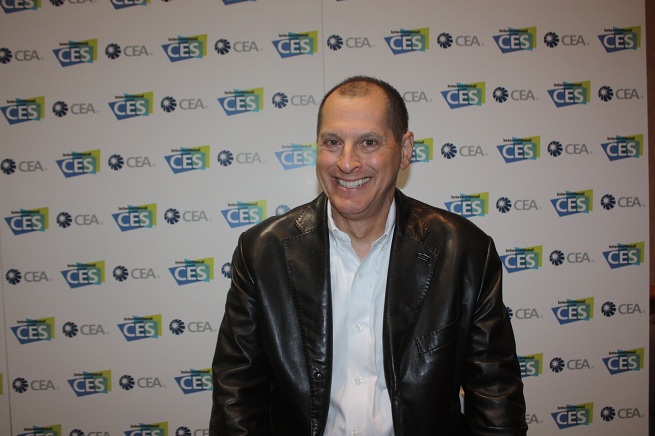There’s a tech boom underway, and that’s good for the industry’s biggest trade show, the 2014 International Consumer Electronics Show, coming Jan. 7 to Jan. 10 in Las Vegas. Gary Shapiro, the president and chief executive of the Consumer Electronics Association, promises that it will be the place to go for innovation.
CES is targeting about 150,000 attendees, 3,300 exhibitors, and about 1.9 million square feet of space. That’s about the same as last year, though exhibitor space has grown. A lot of people will debate whether it’s too crowded to go, or if there will be enough innovation or just a bunch of copycats. But there will be plenty of people there to fill the aisles and lots of new technologies like wearable computers, 3D printing, the Internet of things sensors, fitness watches, car gear, “MommyTech,” tiny mobile gadgets, virtual reality headsets, SteamOS gaming machines, and, of course, giant stereo speakers.
Our preview interview with Shapiro has become an annual ritual. He gets to see the stuff early and sort out the big trends. He also cares a lot about tech policy issues and the overall state of the consumer electronics economy. Here’s an edited transcript of our interview with Shapiro.
Gary Shapiro: We do position the show as the world’s gathering place for everyone who thrives in the business of consumer technologies. It’s all focused on innovation. It’s where innovation goes to market. It’s the promise and the power of technology. It’s everything in the ecosystem. It’s magical. That’s what we do.
I wish I had a different way of saying this, but it’s going to be the best we ever had. [laughs] We have a lot of different trends coming out in a big way. It’s 3,300 different stories from 3,300 different exhibitors.
Running the show itself, we’ve done everything differently that we can. We have new TechZones. We have something called AcademiaTech, focusing on work developed at universities. We have a zone for fashion tech, wearables. That’s become very hot, very quickly. We have the WristRevolution, a new tech zone devoted to wristwatch innovations. There’s a waiting list to get in that one.
The way it works with us, we’re focusing on the 2015 show now. We map it out and say, “We want to reserve these areas for this and that TechZone.” When we go to the show, exhibitors get priority depending on how long they’ve been with us, and they choose their exhibit space. We try to block out TechZones, guessing what might be hot a year ahead of time. Then things come up that we’ve never thought of. It’s a challenge. That’s why some TechZones sell out, because we’ve only allocated so much space.
We have a whole new focus on MEMS, Micro Electro-Mechanical Systems. That’s everything from accelerometers to anything that senses anything. That’s at the core of a lot of new technologies coming down the line. It’s what makes smartphones work. We have a lot in that area. Nine out of the ten largest car companies exhibiting. We have a driverless car TechZone. We have a Go Electric Drive TechZone for electric cars.
One of the hottest areas, as far as selling out, is 3D printing. That’s going to be a major product category. We’re going to see that big-time at CES. It’s on my personal to-buy list for my home. I was watching one that we had here and decided it would help out enormously.
We’re doing a lot with the motion picture industry around Ultra HD and other next-generation stuff. We partner everywhere.
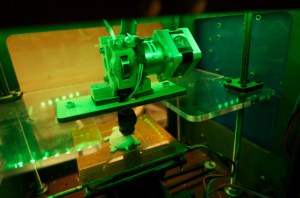
Above: A 3D printer making a turtle.
VB: Is there a lot of a “maker” element to 3D printing, the hobbyist hardware enthusiasts?
Shapiro: Yeah. The CEO of MakerBot is one of the featured speakers at the Leaders in Technology conference. Eureka Park is larger than ever, the startup companies. We’ve created something called Eureka Park Next, with graduates of the program showing where they’re going next. Eureka Park is more than 200 companies now, and this is only the third show we’re doing it.
VB: How did you choose the keynotes this year? What are some of the circumstances that led to the selection of folks you have?
Shapiro: We choose them the way we do every year. We have a brainstorming session and look at our criteria. Those criteria are pretty specific. You must be international. You must be able to say something that’s not just about your company. We want somebody who has something to say. We go for diversity in different senses of the word – diversity of product categories, diversity of geographic regions, diversity in the usual personal sense. Then we list everyone and score them and go after the ones we want.
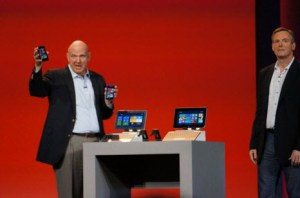
Above: Steve Ballmer came to Qualcomm’s keynote last year.
VB: I see some people who are in the news, like Brian Krzanich from Intel, will be giving a keynote.
Shapiro: Yeah, this is his first presentation, at least from our view. Marissa Mayer, that’s very exciting to us. Sony giving us everything going on in the many different Sony worlds. The success of their game platform gives them good momentum, but they’re doing so many things. They’re a leader in Ultra HD. They’re engaged in so many areas of the motion picture industry. They’ve never disappointed us.
VB: My own joke would be, Microsoft gave up its standing keynote speech just in time for it to have a very interesting product in the Xbox One.
Shapiro: The big surprise this past year was Steve Ballmer coming to the keynote. Whether that will happen again, I have no idea. But Microsoft certainly has a whole bunch of space at CES, although it’s invitation-only space. It’s a pretty huge investment. We would love to have Microsoft back in the future, although I guess it won’t be Steve, absent some strange surprise.
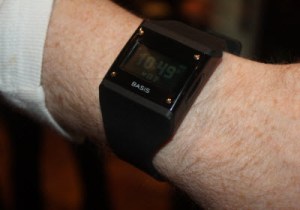
Above: Basis Science’s fitness watch.
The big change for us is that we now have two keynotes before the show officially opens, the night before, with Brian and with Rupert Stadler from Audi. Then it kicks off Tuesday morning with me and Sony. We’ve just announced John Chambers from Cisco. Cisco’s also a part of one of our new areas of the show, the Internet of Things. Everything being connected is a big deal. A lot of exhibitors are focusing on machine-to-machine or thing-to-thing or whatever you want to call it.
Then we have the returning TechZones – the Digital Health Zone, FitnessTech, the Gaming Showcase. The iLounge is still huge. We have Kids at Play, MommyTech, PMA@CES. Robotics is obviously growing. The Silver Summit. Transforming Education. We have more than 25 TechZones. Plus, we still have some announcements – CEOs of major companies appearing, speaking, and doing different things – in all sorts of hot sectors.
VB: I don’t know if attendance is a concern this year. There seems to be a boom going on. I’d think that would be good for the show.
Shapiro: Definitely in terms of quality attendance. The actual number of bodies is always a concern in that we don’t want to have too many people. We’re a little sensitive about keeping it around 150,000. That’s our goal. We don’t want to tax Las Vegas too much with traffic jams and things like that. Our scrutiny level is a little higher this year, I think. It seems to be building in that direction. We don’t want to overtax the system.

Above: Las Vegas has just enough rooms for CES.
VB: Has Las Vegas itself changed much, adding more hotel space or anything like that?
Shapiro: For years, it was 10,000 new rooms a year. It’s slowed down now. They have some plans for the next few years that are really positive, but right now it’s a very gradual increase in rooms. They still have more hotel rooms than any city in the world. They’re about at the 150,000 mark, give or take. And then there are people who rent places that we don’t count, or do day trips. We’re comfortable with 150,000 people. That’s where I would like us to stay.
As far as the mix of those people, we’ve seen an upward spike in international attendees. This is a huge global event. But we don’t know until we finish the show and do an independent audit. They tell us exactly what number we can use.
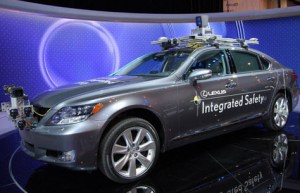
Above: Cars are outfitted with tons of electronics now.
VB: Do you still get around 5,000 or so journalists?
Shapiro: Yeah. Again, that’s the same kind of category. We don’t know until after the show because some people register on site or pre-register and don’t show up. The official numbers are comparable to last year, though, looking at our 2013 finals versus what we’re expecting. We’re at 35,000 international. That’s what we had last year. 5,000 media and analysts. 2,700 financial people. I see there is one change – we had 800 speakers last year and 850 this year. And 200 more exhibitors than last year, roughly. Exhibitors are always cancelling or showing up at the last minute.
VB: Another figure I saw was that there were 300 Apple-related accessory companies.
Shapiro: Yeah, the iLounge portion of the show is well over 300 companies exhibiting.
VB: I recall you were targeting 1.9 million square feet of space. That sounds slightly bigger than last year.
Shapiro: It is going to be bigger, yeah. Bigger than what we ended up with last year. That’s the bottom line. How much bigger depends on, again, what happens at the last minute. There’s still a waiting list in a lot of areas. We’re virtually sold out. The issue we’ve always had with this show, even last year, is that we’re space-limited. We couldn’t get the Sands Convention Center that we needed. For 2015, we will have it.
VB: Last year you mentioned Ultra HD as a hot product. Do you see more of these hot categories coming up, like wearables and so on?
Shapiro: We see a lot of things — 3D printing, Ultra HD. High-resolution audio is something we didn’t even talk about last year, but now Sony is going big there. So are a lot of other companies. We have a little TechZone focused around that, because for those of us who have been around forever, the big shock of MP3 the iPod was that you went down in quality. Now, with fast-growing categories like headphones, we’re finding people want greater quality audio. We’re working with the music industry and others. Companies are producing what we call high-resolution audio. Other trends are obviously robotics, sensor technology, digital health and fitness.
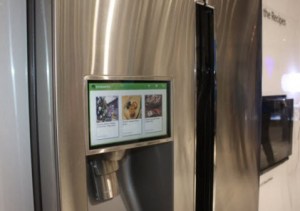
Above: Samsung’s Internet-connected fridge at CES last year.
VB: What are some of the issues that you care about?
Shapiro: We have 35 different tracks in our conference program – automotive, cloud computing, content and Hollywood, digital imaging, gaming, government regulation. If you’re talking about issues in Washington, that’s obviously the one. We just announced that the Secretary of Commerce is coming. I’ll be interviewing her on stage. We also have the new chairman of the FCC, Tom Wheeler, and the other FCC commissioners. Obviously spectrum is a huge issue. Some of the other big government issues are privacy, environmental issues, and energy efficiency.
VB: Has privacy become more heated because of the National Security Agency PRISM revelations this year?
Shapiro: Yes, obviously. But privacy was an issue last year. We’re very focused on the fact that any technology is—When the automobile came along, it caused accidents and people got hurt. The VCR affected Hollywood. The internet affected travel agents. Technology has implications.
The first role of government is to separate what has to be regulated and restricted, like with the Senate’s vote on legislation related to the 3D printing of guns. We haven’t taken a position on that. Just as in the case of the internet and child pornography or gambling, there are certain things that are bad, and society makes a decision that you shouldn’t do them. So we stay back.
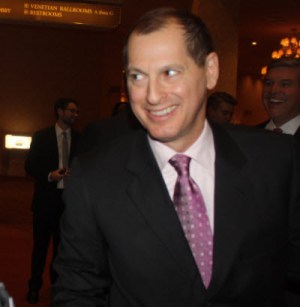
Above: Gary Shapiro of CEA.
But then there are things that people complain about, and we see an issue where we have to oppose. You’ve covered all those battles over the years. We’ve gotten engaged in a whole range of issues over the years, for new things that are innovating and only threatening someone’s business model. It’s not protecting society from harm. That’s where we engage, whether it’s on behalf of Uber or Aereo or the Sony Betamax case or hundreds of other things.
VB: It was interesting to see that coalition form over the weekend, about what to do about government spying.
Shapiro: For a lot of reasons. It’s a big deal for trust issues. It’s a big deal for competitive reasons. If you’re considered a U.S. company now, it may be affecting your competitive status around the world. If you’re a Cisco or an Apple, people will say, “Oh, they’re Americans, they’ve been infiltrated.” There are serious ramifications. Even the car companies have to deal with these issues.
Some would argue that it’s a competitive position to be someone that’s totally trusted. Or you could look at Snapchat. That company has arguably prospered off of a concern about privacy and fear of leaving a trail. They’ve succeeded because kids are fearful of leaving tracks. The last five or ten years, their parents have been telling them – “Don’t do anything on the internet that will hurt you for your rest of their life.” They’ve gotten the message and a successful service was created around it.

Above: When Sony engineers brought out the new 55-inch OLED TV, it crashed and displayed a blue screen. Sony CEO Kaz Hirai said, “Excellent,” in his best sarcastic voice. Hirai will get a second chance this year as a keynote speaker.
VB: There have been a lot of IPOs in the tech industry. You’ve written about innovation in the U.S. and whether it was going to make a comeback. What are you feeling about the state of innovation in the America?

Above: 3D glasses-based gaming lived on at the Nvidia booth, where the company demoed its 3DVision glasses. But few others showed off 3D at the show.
Shapiro: I feel very good in a lot of ways. The U.S. is doing a lot of things right. We worked hard to get legislation passed to allow crowdsourcing. That’s positive. The U.S. system is still a positive system in terms of risk-taking and entrepreneurship and culture. We still have great universities and research that spins off. We still dominate the internet.
The warning clouds are a couple of things we discussed. Our government is causing people to distrust some of our companies, and that’s not healthy. I don’t think the companies have done anything wrong, but there will be aftershocks from that for years to come that we don’t quite understand now. We have to do something about that as a nation. There are concerns that companies have about hiring people and new laws and regulations, whether it’s the Affordable Care Act or in other areas. Our tax code is clearly an issue.
What we’re seeing with the CES is that it’s positioned for any country, any company to innovate. We have a huge delegation coming from France, as far as the number of companies and the things that they’re doing. We have events around the world to promote CES, in Tel Aviv and Paris and London. We’re increasingly going around the world and finding several hundred participants in each location. We hear a lot and we see these companies. Israel is huge. They’re the only country that comes close to the U.S. in terms of innovation, by many measures, whether it’s patents per person and however you want to define it. But France is doing very well in many ways. I’ve been impressed with what they’re doing.
The U.S. is still doing well, though, compared to just about any other company. That’s reflected in what we’re seeing at Eureka Park, what we’re seeing with exhibitors. I’ve signed so many NDA at this point I’ve lost track, so I don’t talk about anything very specifically, but what I will say is that the number of products being introduced at the show is off the chart. Companies have exciting things, exciting speakers, exciting ideas. The CEO-level attendance is off the charts as well, from around the world and in all categories.

Above: Sharp’s 85-inch 8K TV has 16 times as much data per screen compared to HDTV.
VB: What’s your sense for the consumer electronics economy? Is the industry still in a pretty good growth state?
Shapiro: Well, it’s growing. It’s a modest growth. Some areas are going down. Some are going up. Some are new. Again, people define consumer electronics differently, but I define it broadly. When you talk about automotive electronics and cloud computing and the internet of things, the show has become a huge, huge wireless show – the largest wireless show in the world. We’re doing great.
VB: Are you concerned about any categories? I worry a little bit about 4K TV and whether that’s going to be just like 3D TV, which got overhyped and went downhill.
Shapiro: I don’t worry about Ultra HD at all. It’s going to be a huge success. I was quoted in the Wall Street Journal three or four years ago saying that 3D was overhyped, that it was just a feature. I was worried about that at the time. I took some arrows in my industry for saying what I thought about it, but I am not saying that and do not believe it about Ultra HD.
Hollywood is excited about it for the right reasons. On the back of one great movie in Avatar, they and the theater owners thought they could do anything with 3D. But what you have with Ultra HD, we’re hearing from everyone in Hollywood that this thing is phenomenal. Directors say it allows them to show us what they see.
People ask me why I know I’m right. Well, I’ve been right about every new technology since I blew it with the Microsoft Bob. [laughs] I have no doubt that Ultra HD will be a phenomenal success. Beyond Ultra HD, TV in general is a great category now. Obviously it’s great for the consumer, but there’s form factors, there’s the curve, there’s OLED. There’s a lot of exciting things that will be at the show.
VB: Some of these things are maybe a few years out. Do you see anything coming on strong in 2014 in particular?
Shapiro: Everything has its time, and nothing happens overnight. That was what we had to explain about HDTV to a lot of people, and our projections were correct. With Ultra HD we have sales projections that are more gradual. We’ve taken some heat that they’re too conservative. I’m sure we’ll up them by the time it comes to CES and we do new projections.
Is something going to take over the way the iPod and iPhone and iPad did? I can’t see one breakaway that I anticipate. But there’s a lot of really unique stuff. Home control is stepping up quickly. Digital health—I ask audiences how many people are wearing one of these things. Of course, I have select audiences, but it’s usually more than half of these people. What was the year of that? I don’t know. I’m not big on one-year projections.
VB: There’s nothing like a SOPA for you to rally against at the moment.
Shapiro: Oh, yeah. I’m glad you raised that. That was a big deal two years ago. We were told we were going to lose. Senator Wyden had that press conference, and within two weeks the whole thing turned around. The thing I’m optimistic about as far as public policy is the patent reform, the troll thing, which is affecting everyone. We had an incredible bipartisan victory in the House. We’re looking for Senate action. There’s momentum. We have the leadership of both sides. We have President Obama. We’re really happy about that.
That’s the killer that any startup faces. They try and do something and then they get hit by a demand letter. Their funding dries up. Senator Warner expressed it to me directly. He said, “I funded one of these companies. They had a great product. They got a letter, and we couldn’t fund it anymore. No one could.” So there’s an understanding on both sides of the aisle on Capitol Hill that this is a huge issue. From the smallest to the biggest company, we hear about it. That’s my goal for 2014 in Washington, to get the legislation to come along.
Related articles
- The CEA’s Jim Barry: The old man and his gadgets (interview)
- The DeanBeat: With Valve’s Steam Machines and Oculus VR’s funding, gaming innovation is getting interesting
